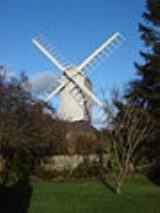
Duck End Mill, Finchingfield
Encyclopedia
Duck End Mill or Letch's Mill is a grade II listed Post mill
at Finchingfield
, Essex
, England
which has been restored.
mill, the roundhouse being added in 1840. The mill was insured for £50 in 1790 and £100 in 1794. The mill was working until c1890, and had an all wood windshaft to the last. This was replaced by the cast iron
one from Gainsford End Mill, Toppesfield
in the 1950s. A replacement wooden windshaft has since been fitted.
. There was one pair of millstone
s, driven by an 8 in 8 in (2.64 m) Brake Wheel. The body of the mill measures 16 in 6 in (5.03 m) by 10 feet (3.05 m) in plan.
References for above:-
Post mill
The post mill is the earliest type of European windmill. The defining feature is that the whole body of the mill that houses the machinery is mounted on a single vertical post, around which it can be turned to bring the sails into the wind. The earliest post mills in England are thought to have...
at Finchingfield
Finchingfield
Finchingfield is a village situated in the Braintree district of Essex. It is in the north-west of the county, which is a primarily rural area...
, Essex
Essex
Essex is a ceremonial and non-metropolitan county in the East region of England, and one of the home counties. It is located to the northeast of Greater London. It borders with Cambridgeshire and Suffolk to the north, Hertfordshire to the west, Kent to the South and London to the south west...
, England
England
England is a country that is part of the United Kingdom. It shares land borders with Scotland to the north and Wales to the west; the Irish Sea is to the north west, the Celtic Sea to the south west, with the North Sea to the east and the English Channel to the south separating it from continental...
which has been restored.
History
Duck End Mill was built in the mid eighteenth century, dates of 1756, 1760 1773 and 1777 being recorded in the mill. It was originally built as an open trestleTrestle (mill)
The Trestle of a Post mill is the arrangement of the Main post, crosstrees and quarterbars that form the substructure of this type of windmill. It may or may not be surrounded by a roundhouse...
mill, the roundhouse being added in 1840. The mill was insured for £50 in 1790 and £100 in 1794. The mill was working until c1890, and had an all wood windshaft to the last. This was replaced by the cast iron
Cast iron
Cast iron is derived from pig iron, and while it usually refers to gray iron, it also identifies a large group of ferrous alloys which solidify with a eutectic. The color of a fractured surface can be used to identify an alloy. White cast iron is named after its white surface when fractured, due...
one from Gainsford End Mill, Toppesfield
Toppesfield
Toppesfield is a small village, historically associated with arable farming, in north Essex, England.-Inhabitants:Toppesfield has approximately three-hundred inhabitants...
in the 1950s. A replacement wooden windshaft has since been fitted.
Description
Duck End Mill is a post mill with a single storey roundhouse. The mill is winded by a tailpole. It has four Spring sailsWindmill sail
Windmills are powered by their sails. Sails are found in different designs, from primitive common sails to the advanced patent sails.-Jib sails:...
. There was one pair of millstone
Millstone
Millstones or mill stones are used in windmills and watermills, including tide mills, for grinding wheat or other grains.The type of stone most suitable for making millstones is a siliceous rock called burrstone , an open-textured, porous but tough, fine-grained sandstone, or a silicified,...
s, driven by an 8 in 8 in (2.64 m) Brake Wheel. The body of the mill measures 16 in 6 in (5.03 m) by 10 feet (3.05 m) in plan.
Millers
- Samuel Stammers 1790 - 1807
- Edward Stammers 1807 - 1817
- Edward Letch 1817 - 1852
- Edward Letch Jr 1852 -
- Andrew Luke Letch -1890
References for above:-
External links
- Windmill World webpage on Duck End Mill.

